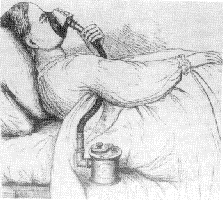Question: In our 300-bed hospital, we have about 550 OB anesthetics per year. Obstetricians are objecting to our policy of refusing to institute epidural analgesia for labor unless there is a qualified obstetrician actually in the labor suite and who will stay throughout the labor. What is the current standard of safe anesthetic practice?
Answer: The Joint Statement on the Optimal Goals for Anesthesia Care in Obstetrics, issued in 1988 by the American Society of Anesthesiologists and the American College of Obstetricians and Gynecologists addresses this issue quite dearly. Paragraph V reads as follows:

In 1866, the obstetrician probably was in attendance when this self-administered Ether-Chloroform-Alcohol vaporizer was in use for labor discomfort. Illustration courtesy of the Wood Library-Museum, American Society of Anesthesiologists.
“Availability of a qualified obstetrician during administration of anesthesia. Major conduction anesthesia (epidural, caudal or spinal) and/or general anesthesia should not be administered until the patient has been examined, and the fetal status and progress of labor evaluated by a qualified physician who is readily available to supervise the labor and to deal with any obstetric complications that may arise”.
Thus, although the obstetrician is not required to be physically present in the Delivery Suite throughout the conduct of epidural anesthesia, he should be close enough and capable of responding effectively to any obstetric emergency.
Answer by M. Finster, M.D.; Professor of Anesthesiology, Obstetrics and Gynecology, Columbia University, New York.

